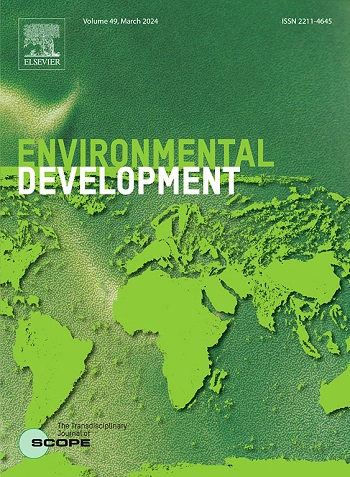Differential effects of vegetation types on regional carbon stocks in China: A meta-analysis-based integrated assessment of above-ground and surface soil carbon pools
IF 5.3
2区 环境科学与生态学
Q2 ENVIRONMENTAL SCIENCES
引用次数: 0
Abstract
In Chinese terrestrial ecosystems, above-ground carbon (AGC) and surface soil organic carbon (SOC) constitute critical components of vegetation carbon stocks. This study offers a more comprehensive analysis of the mechanisms that influence carbon sequestration. Through a meta-analysis of 173 peer-reviewed studies, the research examined three major natural ecosystems: trees, shrubs, and grasses. Key findings reveal: (1) The trees exhibited the highest carbon sequestration capacity (AGC = 4.73, SOC = 2.34), followed by shrubs (AGC = 1.07, SOC = 2.66) and grasses (AGC = −1.07, SOC = 1.37), with all values compared to control farmland. (2) Regional divergence: Tree AGC was highest in Northeast (13.29) and North China (6.87); Grass AGC was lower than farmland in Inner Mongolia (−7.94), Southeast (−3.56), and Northwest China (−2.21); SOC was most prominent for trees and shrubs in Southwest China (3.77 and 4.48, respectively); Grass SOC peaked in Central China (4.24); Comparative analysis showed tree AGC generally exceeded SOC, while grasses exhibited the opposite pattern; Shrubs demonstrated higher AGC than SOC in northern regions, with the reverse pattern in southern regions. (3) Climatic thresholds: High precipitation (>1500 mm) maximally enhances AGC and SOC capacities for trees and shrubs, with SOC further enhanced at >15 °C; Grasses demonstrate optimal carbon sequestration under moderate conditions (5–15 °C and 1000–1500 mm). These findings emphasize the critical importance of considering vegetation type, regional heterogeneity, and climatic thresholds in developing forest management strategies for enhanced carbon sink optimization. The study provides valuable insights for ecosystem-specific carbon management approaches in China's diverse terrestrial environments.
植被类型对中国区域碳储量的差异影响——基于元分析的地上与地表土壤碳库综合评价
在中国陆地生态系统中,地上碳(AGC)和表层土壤有机碳(SOC)是植被碳储量的重要组成部分。这项研究对影响碳固存的机制进行了更全面的分析。通过对173项同行评议研究的荟萃分析,该研究检查了三种主要的自然生态系统:树木、灌木和草。结果表明:(1)与对照农田相比,乔木的固碳能力最高(AGC = 4.73, SOC = 2.34),灌木次之(AGC = 1.07, SOC = 2.66),禾草次之(AGC = - 1.07, SOC = 1.37)。②区域差异:Tree AGC在东北(13.29)和华北(6.87)最高;草地AGC低于内蒙古(- 7.94)、东南(- 3.56)和西北(- 2.21)农田;西南地区乔木和灌木的有机碳含量最高,分别为3.77和4.48;草地有机碳在华中地区最高(4.24);对比分析表明,乔木AGC普遍高于有机碳,禾本科则相反;北部地区灌木的AGC高于有机碳,南部地区则相反。(3)气候阈值:高降水(1500 mm)最大限度地提高了乔灌木的AGC和有机碳容量,在15°C时有机碳进一步增强;在中等条件下(5-15°C和1000-1500 mm),草具有最佳的固碳能力。这些发现强调了考虑植被类型、区域异质性和气候阈值在制定加强碳汇优化的森林管理策略中的关键重要性。该研究为中国不同陆地环境下的生态系统碳管理方法提供了有价值的见解。
本文章由计算机程序翻译,如有差异,请以英文原文为准。
求助全文
约1分钟内获得全文
求助全文
来源期刊

Environmental Development
Social Sciences-Geography, Planning and Development
CiteScore
8.40
自引率
1.90%
发文量
62
审稿时长
74 days
期刊介绍:
Environmental Development provides a future oriented, pro-active, authoritative source of information and learning for researchers, postgraduate students, policymakers, and managers, and bridges the gap between fundamental research and the application in management and policy practices. It stimulates the exchange and coupling of traditional scientific knowledge on the environment, with the experiential knowledge among decision makers and other stakeholders and also connects natural sciences and social and behavioral sciences. Environmental Development includes and promotes scientific work from the non-western world, and also strengthens the collaboration between the developed and developing world. Further it links environmental research to broader issues of economic and social-cultural developments, and is intended to shorten the delays between research and publication, while ensuring thorough peer review. Environmental Development also creates a forum for transnational communication, discussion and global action.
Environmental Development is open to a broad range of disciplines and authors. The journal welcomes, in particular, contributions from a younger generation of researchers, and papers expanding the frontiers of environmental sciences, pointing at new directions and innovative answers.
All submissions to Environmental Development are reviewed using the general criteria of quality, originality, precision, importance of topic and insights, clarity of exposition, which are in keeping with the journal''s aims and scope.
 求助内容:
求助内容: 应助结果提醒方式:
应助结果提醒方式:


